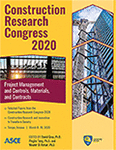Construction Research Congress 2020
Chronographical Spatiotemporal Planning for Construction Projects
Publication: Construction Research Congress 2020: Project Management and Controls, Materials, and Contracts
ABSTRACT
Most building projects are scheduled using the Gantt/Precedence diagram method, which is a timeline scheduling approach that combines a graphical representation of activities through a bar chart diagram and constraints on precedence dependencies logic. The linear diagram is also marginally used for scheduling building projects. The lack of consideration of the sequence of work and traffic in the limited spaces of construction sites makes the resolution of conflicts more complex; deterministic and stochastic mathematical optimization techniques have been used to solve these problems. However, these solutions are less viable for application in real projects. There are too many parameters to be considered or processed with reasonable efforts and time. Graphic modeling is considered an appropriate solution because of its communication capability. Coordination and decision-making on construction sites become simpler, and spatiotemporal graphical planning is then more suitable as a scheduling model because it considers activities, resources, and spaces simultaneously. This paper presents an explanation of the chronographical spatiotemporal modeling solution that integrates considerations of the space, crews, and operations in the same image. The objective is to link the spatial and temporal aspects to ensure suitable rotation of the workforce in various spaces and efficient linear production. An approach that calculates the project duration is based on critical space and the site occupancy rate; the model also defines seven space management layers (creation of spaces, installation of systems, envelopes, division of spaces, finishing, closing of spaces, and exterior works). The validation process was performed using several case studies on scheduling building projects. In conclusion, the integration of spaces, operations, and temporal aspects promotes efficient use of building sites and helps managers maximize the site occupancy rates, ensure suitable rotation of the workforce between zones and support linear productions of spaces and teams.
Get full access to this article
View all available purchase options and get full access to this chapter.
REFERENCES
Ballard, G. (2000). The Last Planner System of production control. PhD thesis, Department of Civil Engineering, University of Birmingham, Birmingham.
Burkhardt, A. F. (1989). “Short interval production scheduling.” ASCE Construction Congress I, Mar., ASCE.
Chua, D.K.H., Yeoh, K.W., Song, Y. (2010). “Quantification of spatial temporal congestion in four-dimensional computer-aided design.” J. Const. Eng, Mgmt, 136 (6): 641-49.
Fisk, R.E., and Reynolds, W.D. (2014). Construction projects administration, 10th edn., Pearson Education inc., N.J.
Francis, A. (2013). “The Chronographical Approach for Construction Project Modelling.” Mgmt, Proc, & Law, ICE Publishing, 166 (4): 188–204.
Francis, A. (2016). “A Chronographic Protocol for Modelling Construction Projects.” Mgmt, Proc, & Law, ICE Publishing, 169 (4): 168–77.
Francis, A., and Morin-Pepin, S. (2017). “The Concept of Float Calculation Based on the Site Occupation Using the Chronographical Logic.” In Procedia Eng., Elsevier, 196:690–97.
Francis, A. (2019). “Chronographical Spatiotemporal Scheduling Optimization for Building Projects.” Frontiers Bldg Env., 5: 1-14.
Frandson, A., and Tommelein, I. D. (2014). “Development of a Takt-Time Plan: A Case Study.” Construction Research Congress 2014: Construction in a Global Network - Proceedings of the 2014 Const. Rsrch Cong., May. Reston, VA: American Society of Civil Engineers, 1646–55.
Horman, M., Messner, J., Riley, D., and Pulaski, M. (2003). “Using buffers to manage production: A case study of the pentagon renovation project.” Int. Group Lean Const. 11th Annual Conf., IGLC.
Riley, D., and Sanvido, V. E. (1995). “Patterns of construction-space use in multistory buildings.” J. Const. Eng, Mgmt, 121 (4): 464-73.
Riley, D., and Sanvido, V. E. (1997). “Space Planning Method for Multistory Building Construction.” J. Const. Eng, Mgmt, 123 (2): 171-80.
Su, X., and Cai, H. (2014), “Life Cycle Approach to Construction Workspace Modeling and Planning”, J. Const. Eng, Mgmt, 140(7), 1-12.
Tufte, E.R. (1983). “The Visual Display of Quantitative Information.” Cheshire, CT, USA, Graphics Press.
Winch, G. M., and North, S. (2006). “Critical space analysis.” J. Const. Eng, Mgmt, 132(5): 473-81.
Zouein, P. P., and Tommelein, I. D. (2001). “Improvement Algorithm for Limited Space Scheduling.” J. Const. Eng, Mgmt, 127(2): 116-24.
Information & Authors
Information
Published In
Construction Research Congress 2020: Project Management and Controls, Materials, and Contracts
Pages: 201 - 209
Editors: David Grau, Ph.D., Arizona State University, Pingbo Tang, Ph.D., Arizona State University, and Mounir El Asmar, Ph.D., Arizona State University
ISBN (Online): 978-0-7844-8288-9
Copyright
© 2020 American Society of Civil Engineers.
History
Published online: Nov 9, 2020
Published in print: Nov 9, 2020
Authors
Metrics & Citations
Metrics
Citations
Download citation
If you have the appropriate software installed, you can download article citation data to the citation manager of your choice. Simply select your manager software from the list below and click Download.
